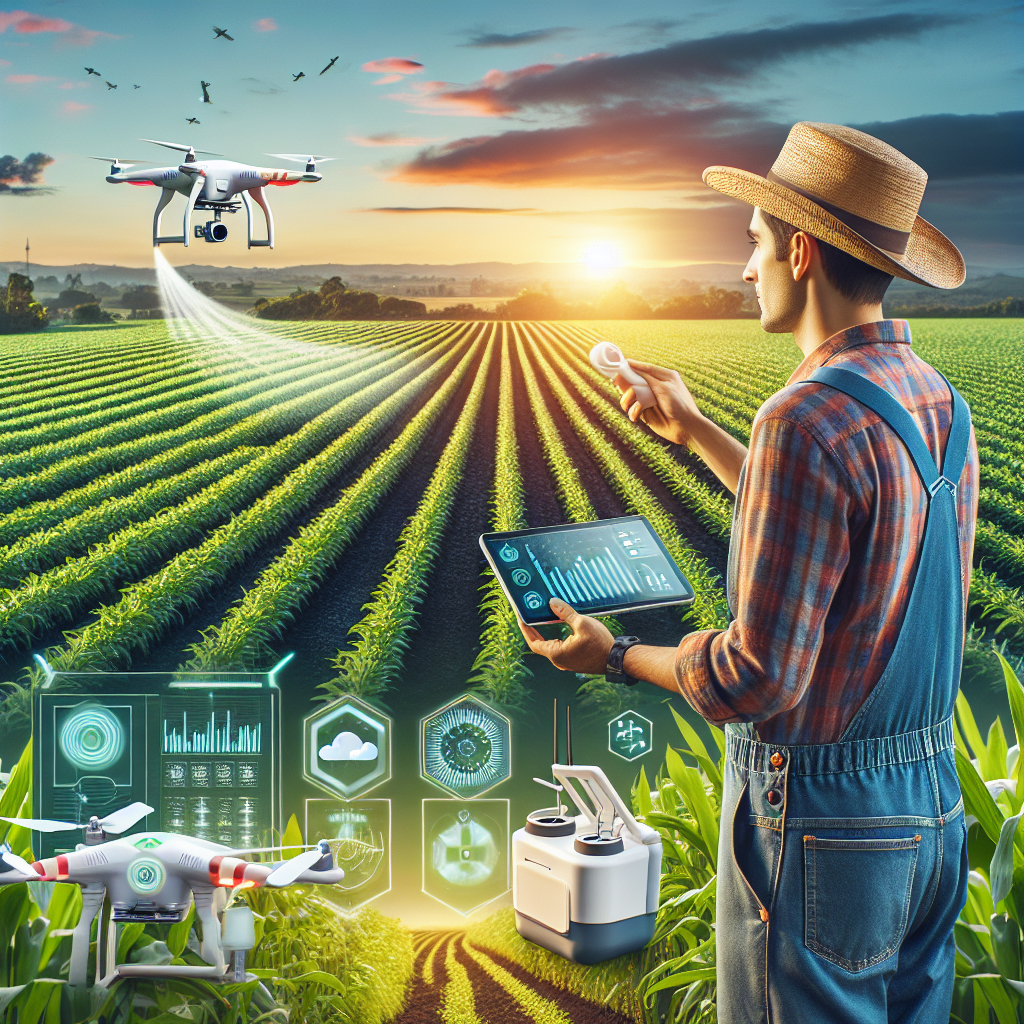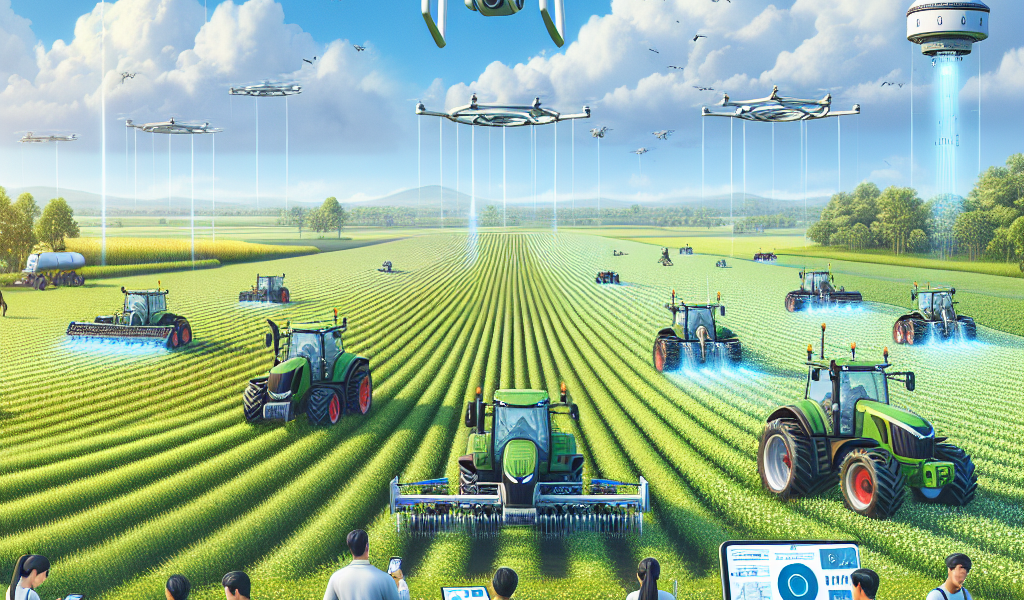-
Table of Contents
“Harvesting Innovation: Unlocking the Potential of Smart Agriculture”
Introduction

Smart agriculture, also known as precision farming, represents a transformative approach to agricultural practices by integrating advanced technologies such as the Internet of Things (IoT), artificial intelligence (AI), and big data analytics. This innovative method aims to enhance the efficiency, productivity, and sustainability of farming operations. By leveraging real-time data and automated systems, smart agriculture enables farmers to make informed decisions, optimize resource usage, and reduce environmental impact. The adoption of smart agriculture technologies promises to address the growing global food demand, mitigate the effects of climate change, and ensure the long-term viability of agricultural ecosystems. This exploration delves into the myriad benefits of smart agriculture, highlighting its potential to revolutionize the agricultural sector and contribute to a more sustainable future.
Enhancing Crop Yields with Precision Farming
In recent years, the agricultural sector has witnessed a technological revolution that promises to transform traditional farming practices. One of the most significant advancements in this domain is precision farming, a method that leverages technology to enhance crop yields and optimize resource use. As the global population continues to grow, the demand for food production increases, making it imperative for farmers to adopt innovative techniques to meet these needs efficiently. Precision farming, often referred to as smart agriculture, offers a solution by integrating data-driven approaches to farming.
At the heart of precision farming lies the use of advanced technologies such as GPS, IoT (Internet of Things), and AI (Artificial Intelligence). These tools enable farmers to collect and analyze data about their fields with unprecedented accuracy. For instance, GPS technology allows for the precise mapping of fields, which helps in identifying variations in soil properties, moisture levels, and crop health. This granular level of detail empowers farmers to make informed decisions about where to plant, irrigate, and apply fertilizers, ultimately leading to better crop management.
Moreover, IoT devices play a crucial role in smart agriculture by providing real-time monitoring of various environmental factors. Sensors placed in the fields can measure soil moisture, temperature, and humidity, transmitting this data to a central system. This continuous flow of information allows farmers to respond promptly to changing conditions, ensuring that crops receive the optimal amount of water and nutrients. Consequently, this not only enhances crop yields but also conserves valuable resources, making farming more sustainable.
Transitioning to the benefits of AI, machine learning algorithms can analyze vast amounts of data collected from the fields to predict crop performance and identify potential issues before they become critical. For example, AI can detect early signs of pest infestations or diseases, enabling farmers to take preventive measures swiftly. This proactive approach reduces the reliance on chemical pesticides, promoting healthier crops and minimizing environmental impact.
Furthermore, precision farming extends beyond the field to include the entire supply chain. By using blockchain technology, farmers can track the journey of their produce from farm to table, ensuring transparency and traceability. This not only builds consumer trust but also helps in maintaining the quality and safety of agricultural products. Additionally, data collected through precision farming can be shared with agricultural researchers and policymakers, contributing to the development of better farming practices and policies.
While the advantages of precision farming are evident, it is essential to acknowledge the challenges that come with its implementation. The initial investment in technology and infrastructure can be substantial, posing a barrier for small-scale farmers. However, as technology becomes more accessible and affordable, it is expected that more farmers will adopt these practices. Governments and agricultural organizations can also play a pivotal role by providing financial support and training programs to help farmers transition to smart agriculture.
In conclusion, precision farming represents a significant leap forward in the quest to enhance crop yields and ensure sustainable food production. By harnessing the power of technology, farmers can optimize their practices, conserve resources, and improve the quality of their produce. As the world continues to face the challenges of climate change and population growth, embracing smart agriculture will be crucial in securing a resilient and efficient agricultural future.
Reducing Environmental Impact through Smart Irrigation Systems
Smart agriculture is revolutionizing the way we approach farming, and one of the most significant advancements in this field is the development of smart irrigation systems. These systems are designed to optimize water usage, ensuring that crops receive the precise amount of water they need, when they need it. This not only enhances crop yield but also plays a crucial role in reducing the environmental impact of agricultural practices.
To begin with, traditional irrigation methods often lead to water wastage. Farmers typically rely on fixed schedules or manual assessments to determine when and how much to water their crops. This can result in over-irrigation, where excess water seeps into the ground, carrying away valuable nutrients and potentially contaminating local water sources. Conversely, under-irrigation can stress plants, reducing their growth and productivity. Smart irrigation systems address these issues by using advanced technologies such as soil moisture sensors, weather forecasts, and satellite imagery to make real-time decisions about water application.
Moreover, these systems are equipped with automated controls that adjust irrigation schedules based on the specific needs of the crops and the prevailing environmental conditions. For instance, if a weather forecast predicts rain, the system can delay watering to prevent over-saturation. This level of precision not only conserves water but also ensures that plants receive the optimal amount of moisture, promoting healthier growth and higher yields.
In addition to conserving water, smart irrigation systems contribute to reducing the carbon footprint of agriculture. Traditional irrigation methods often require significant energy inputs, particularly when water needs to be pumped from distant sources. By optimizing water usage, smart systems reduce the energy required for pumping and distribution. Furthermore, the integration of renewable energy sources, such as solar-powered pumps, can further diminish the reliance on fossil fuels, making the entire process more sustainable.
Another critical aspect of smart irrigation is its ability to minimize nutrient runoff. When excess water is applied to fields, it can carry fertilizers and pesticides into nearby rivers and lakes, leading to eutrophication and harming aquatic ecosystems. By precisely controlling the amount of water used, smart irrigation systems help to keep these chemicals within the root zone of the crops, where they are most effective. This not only protects water quality but also reduces the need for additional chemical applications, further lowering the environmental impact.
The benefits of smart irrigation extend beyond environmental conservation. Farmers who adopt these systems often see significant cost savings. Reduced water usage translates to lower utility bills, and the improved efficiency can lead to higher crop yields and better-quality produce. Additionally, the data collected by smart irrigation systems can provide valuable insights into crop health and soil conditions, enabling farmers to make more informed decisions and further optimize their practices.
While the initial investment in smart irrigation technology can be substantial, the long-term benefits make it a worthwhile consideration for many farmers. Governments and agricultural organizations are increasingly recognizing the potential of these systems and are offering incentives and support to encourage their adoption. As more farmers embrace smart irrigation, the cumulative impact on water conservation and environmental sustainability could be profound.
In conclusion, smart irrigation systems represent a significant advancement in agricultural technology, offering a range of benefits that extend from water conservation and energy efficiency to improved crop yields and reduced environmental impact. By leveraging advanced technologies and data-driven insights, these systems are helping to create a more sustainable and resilient agricultural sector, paving the way for a greener future.
Leveraging IoT for Real-Time Agricultural Monitoring
In recent years, the agricultural sector has witnessed a technological revolution, with the Internet of Things (IoT) playing a pivotal role in transforming traditional farming practices. Leveraging IoT for real-time agricultural monitoring is not just a futuristic concept but a present-day reality that offers numerous benefits to farmers and the broader agricultural community. This technological advancement is reshaping how we approach farming, making it more efficient, sustainable, and productive.
To begin with, IoT devices enable farmers to monitor their crops and livestock in real-time, providing invaluable data that can be used to make informed decisions. For instance, sensors placed in the soil can measure moisture levels, temperature, and nutrient content, allowing farmers to optimize irrigation and fertilization schedules. This precise control over farming inputs not only enhances crop yields but also conserves resources, addressing the growing concerns over water scarcity and environmental sustainability.
Moreover, IoT technology facilitates the early detection of potential issues, such as pest infestations or plant diseases. By continuously monitoring the health of crops, these smart systems can alert farmers to any anomalies, enabling them to take swift action before the problem escalates. This proactive approach significantly reduces crop losses and minimizes the need for chemical interventions, promoting a healthier and more eco-friendly farming environment.
Transitioning to livestock management, IoT devices are equally transformative. Wearable sensors on animals can track their health, behavior, and location, providing farmers with real-time insights into their well-being. For example, these sensors can detect early signs of illness, stress, or abnormal behavior, allowing for timely veterinary intervention. Additionally, GPS-enabled collars can prevent livestock from straying too far, reducing the risk of loss and ensuring their safety.
Furthermore, the integration of IoT in agriculture extends beyond individual farms. By aggregating data from multiple sources, farmers can gain access to broader insights and trends that can inform their practices. For instance, weather stations equipped with IoT sensors can provide hyper-local weather forecasts, helping farmers plan their activities more effectively. This collective intelligence fosters a more collaborative and informed agricultural community, where knowledge sharing and data-driven decision-making become the norm.
Another significant advantage of IoT in agriculture is its potential to reduce labor costs and increase operational efficiency. Automated systems, such as drones and robotic machinery, can perform tasks like planting, harvesting, and monitoring with precision and consistency. These technologies not only alleviate the physical burden on farmers but also ensure that agricultural activities are carried out with optimal timing and accuracy. As a result, farmers can focus on strategic planning and management, rather than being bogged down by repetitive manual tasks.
In addition to these practical benefits, the adoption of IoT in agriculture also has economic implications. By improving crop yields, reducing resource wastage, and minimizing losses, IoT technology can enhance the profitability of farming operations. This financial boost is particularly crucial for small-scale farmers, who often operate on thin margins and face numerous challenges. With IoT, they can achieve greater productivity and sustainability, ensuring their long-term viability in an increasingly competitive market.
In conclusion, leveraging IoT for real-time agricultural monitoring offers a multitude of benefits that are revolutionizing the farming landscape. From optimizing resource use and enhancing crop and livestock health to fostering collaboration and improving economic outcomes, IoT technology is paving the way for a smarter, more sustainable future in agriculture. As farmers continue to embrace these innovations, the potential for growth and improvement in the sector is boundless, promising a brighter and more resilient agricultural industry for generations to come.
Conclusion
In conclusion, exploring the benefits of smart agriculture reveals significant potential for enhancing productivity, sustainability, and efficiency in farming practices. By leveraging advanced technologies such as IoT, AI, and data analytics, smart agriculture can optimize resource use, reduce environmental impact, and improve crop yields. This approach not only addresses the growing global food demand but also supports the economic viability of farming communities. As the agricultural sector continues to adopt these innovations, the promise of a more resilient and sustainable food system becomes increasingly attainable.





